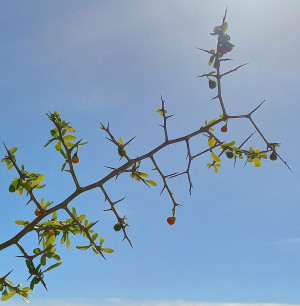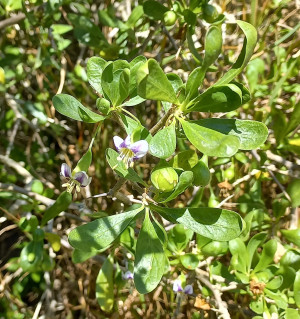Boxthorn (Lycium ferocissimum) is an evergreen pest plant, originating from South Africa. Boxthorn was originally introduced as a hedge but has revealed itself to be a significant pest elsewhere.
Tasman is one of those places. It is an Eradication Pest in the Tasman-Nelson Regional Pest Management Plan.
It can form dense, tall prickly stands that exclude native plant species, and can also entangle seabirds such as petrels.
The thorn pines can become embedded in bone or soft tissue, causing infection and pseudo-tumours.
It tolerates drought, wind, salt and extremes of temperature, and will colonise rocky cliffs, roadsides, gravel and coastal areas.
The tough, woody stems of boxthorn branch off at square angles, creating the distinctive box-like pattern it is named for. Branches harbour sharp, rigid spines, an adaptation against browsing by African ungulates.
 Boxthorn leaves are hairless, fleshy and usually bright green. They are oblong shaped, but wider towards the tip, around 4cm long and 1cm wide.
Boxthorn leaves are hairless, fleshy and usually bright green. They are oblong shaped, but wider towards the tip, around 4cm long and 1cm wide.
From July to March, white to pale mauve flowers are produced, around 1cm long. These result in tear-shaped orange-red berries in autumn, which are spread mainly by birds. We have recently discovered that goats also spread boxthorn by browsing on the plant and fruits.
If you think you have seen this pest plant, please contact our Biosecurity Team on 03 543 8400 or [email protected].


